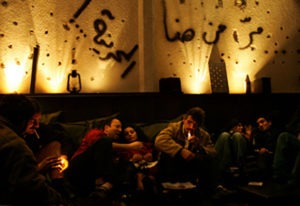
The Role of Photography in Construction of Alterity
 Nightclub in Beirut, Lebanon (Stephanie Sinclair, 2005)
Nightclub in Beirut, Lebanon (Stephanie Sinclair, 2005)
In July of 2006, during a bout of intense border battles between Israeli armed forces and members of Lebanon’s Hezbollah militia, a photograph made by Stephanie Sinclair achieved a broad second life on the Internet when it accompanied a post on food writer and Travel Channel star Anthony Bourdain’s blog; Bourdain and crew had been filming an episode of No Reservations in Beirut and were “trapped” in the city owing to the destruction of the airport and an naval blockade effectively halting departures by Americans from the Gulf states. The photograph had originally appeared on March 12, 2005, in the Travel section of the New York Times with a story by Scott Spencer about the nonchalant nightlife scene in Beirut following the assassination of Lebanese prime minister Rafik Hariri. The image was described in the Times as “Love among the ruins at the war-themed Beirut club known as 1975,” and on Bourdain’s blog with the following caption: “Prewar partygoers enjoy the music and atmosphere at 1975, a bar whose theme is the country’s civil war.”
The odd syntax of the cutlines suggests that “the war” was an omnipresent future, past, and present entity. Regardless of the date the image was made, though, its placement in the context of stories about a “live,” ongoing military flare-up, even amid the larger ceaseless tragedy in the Middle East, makes the powerful suggestion that Beirutis party even as rockets and air strikes devastate the buildings around them.
(more…)